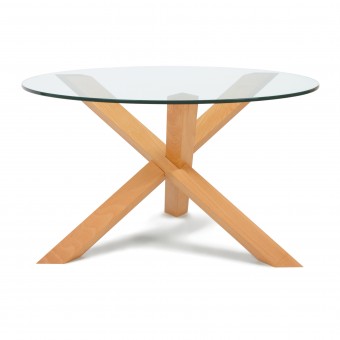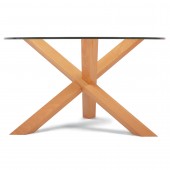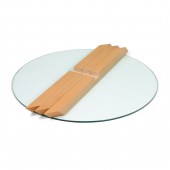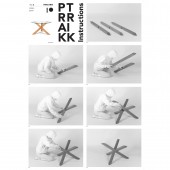
| THE AWARD |
| CATEGORIES |
| REGISTRATION |
| SUBMIT YOUR WORK |
| ENTRY INSTRUCTIONS |
| TERMS & CONDITIONS |
| PUBLICATIONS |
| DATES & FEES |
| METHODOLOGY |
| CONTACT |
| WINNERS |
| PRESS ROOM |
| GET INVOLVED |
| DESIGN PRIZE |
| DESIGN STORE |
| THE AWARD | JURY | CATEGORIES | REGISTRATION | PRESS | WINNERS | PUBLICATIONS | ENTRY INSTRUCTIONS |
1x3 Coffee Table by Petar Zaharinov |
Home > Winners > Design #22958 >Interview |
 |
|
FS: What is the main principle, idea and inspiration behind your design?
PZ: 1x3 is inspired by so called burr puzzles. They are type of mechanical puzzles where all parts are interlocked and stay together without any fixtures. I found them suitable for utilization.
FS: What has been your main focus in designing this work? Especially what did you want to achieve?
PZ: I wanted to achieve what I call "sophistication free" design. It means a design that can be produced easily and is made of very simple elements and traditional materials. The production in general is getting more and more hi-tech, the details more and more complicated and specific for each manufacturer. I think there is still space for movement in the opposite direction!
FS: What are your future plans for this award winning design?
PZ: The table is already a product with a special reusable bag, assembly manual etc. I will probably try to use its interlocking principle for other applications.
FS: How long did it take you to design this particular concept?
PZ: It is not easy to give an exact period of time. 1x3 is one of several designs following the same concept that I developed simultaneously. The whole process, from the first sketch to the prototypes, of all those designs, took about an year.
FS: Why did you design this particular concept? Was this design commissioned or did you decide to pursuit an inspiration?
PZ: It was an inspiration. This is always the way for me. I first invent a principle and then decide in which field to apply it. In this case it was furniture design. Before that I was not very interested in product design, mainly in architecture.
FS: Is your design being produced or used by another company, or do you plan to sell or lease the production rights or do you intent to produce your work yourself?
PZ: The design has been already produced by my own company called PRAKTRIK. I founded it together with my business partner an year ago particularly for this design and the other pieces I mentioned before. Selling or leasing the production rights is possible.
FS: What made you design this particular type of work?
PZ: I am interested in geometry. I believe that form and materials are critical for the way the objects around us influence us. Symmetry is also something very important to me. I tried to design an object that involves all these and is modern at the same time.
FS: Where there any other designs and/or designers that helped the influence the design of your work?
PZ: Not really. I usually try to find inspiration in other fields that are different from architecture and product design. I also avoid watching magazines and blogs while I am working on something; because, it can make me imitate some one else's works.
FS: Who is the target customer for his design?
PZ: Middle class customers for the moment. My dream is to be mass produced and spread but only the time can show if it is appropriate for the majority of people.
FS: What sets this design apart from other similar or resembling concepts?
PZ: Probably the simplicity in both: geometry and technology. I have seen similar designs, but they are more complicated in the geometry of their notches requiring more complicated technology.
FS: How did you come up with the name for this design? What does it mean?
PZ: The name of the design represents its structure. It is a mathematical expression that gives the total number of wooden elements. The first number corresponds to the number of element types. The second one represents the number of elements of each type.
FS: Which design tools did you use when you were working on this project?
PZ: For the design process I used a 3D CAD software and small models. For the prototypes I bought a special machine called scroll saw which I adapted for this particular purpose.
FS: What is the most unique aspect of your design?
PZ: Probably the fact that three rectangular sticks can stay stable without the need of any fixtures.
FS: Who did you collaborate with for this design? Did you work with people with technical / specialized skills?
PZ: I designed it by myself, including the first prototype. I worked with professionals in woodworking to develop the complete product. I also worked with graphic designers to develop its visual identity: assembly manual catalogue, reusable bag etc.
FS: What is the role of technology in this particular design?
PZ: It is not critical for 1x3; because, it can be produced by many ways including very traditional ones but it does not mean that the technology is not important at all. The possibility of using only low-tech was an important part of the concept; as a result, a good table saw is completely enough for the production of the wooden base. The material is also important. It is traditional and proved to be harmless for human health, it is also native for burr puzzles.
FS: Is your design influenced by data or analytical research in any way? What kind of research did you conduct for making this design?
PZ: After I saw the potential for utilization of interlocking puzzles I started to examine the existing ones but they appeared to be too complicated and difficult to produce or assemble. Actually my task was just the opposite of the one of a classical puzzle maker; because, I had to design structures that are simple and easy to assemble.
FS: What are some of the challenges you faced during the design/realization of your concept?
PZ: I had to work in an area that is different from my profession - architecture. The scale is very different. In architecture I design for a particular client, in this case I had to be the client, or at least to imagine what a client would look for.
FS: How did you decide to submit your design to an international design competition?
PZ: Winning a competition was not my goal. Every competition is specific and different and designing a product just for winning a competition at all costs does not make sense to me. I wanted to check if this particular design is interesting to professionals: professors, designers etc.
FS: What did you learn or how did you improve yourself during the designing of this work?
PZ: Most of the things I learned during the process are related to woodworking. I also had to work with other people to finish the whole product, I learned a lot from them.
FS: Thank you for providing us with this opportunity to interview you.
A' Design Award and Competitions grants rights to press members and bloggers to use parts of this interview. This interview is provided as it is; DesignPRWire and A' Design Award and Competitions cannot be held responsible for the answers given by participating designers.
| SOCIAL |
| + Add to Likes / Favorites | Send to My Email | Comment | View Press-Release | Translations |





